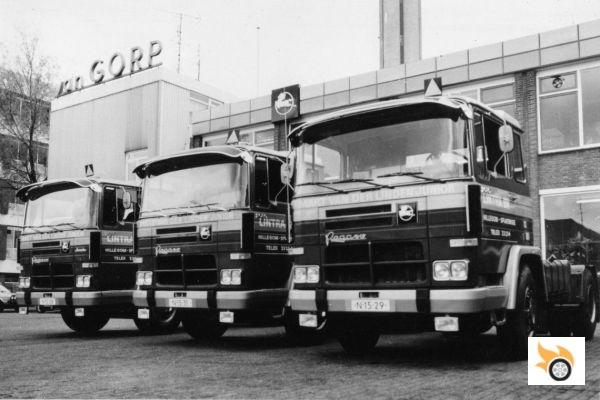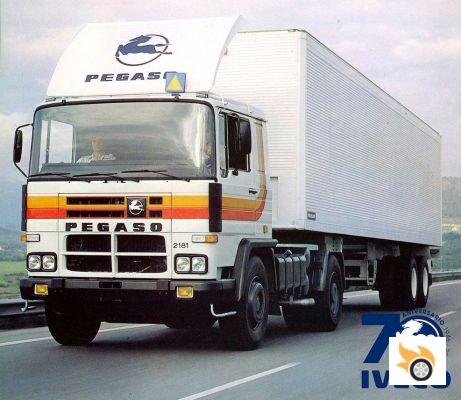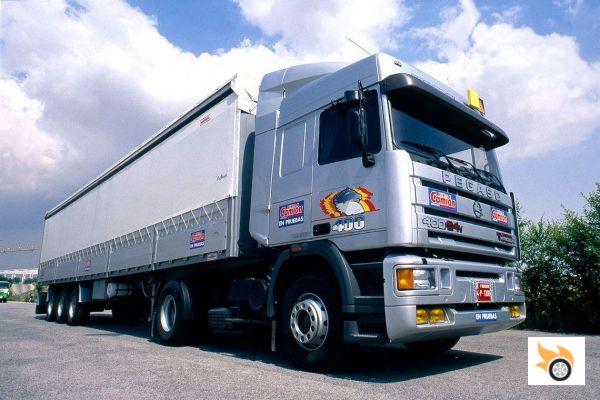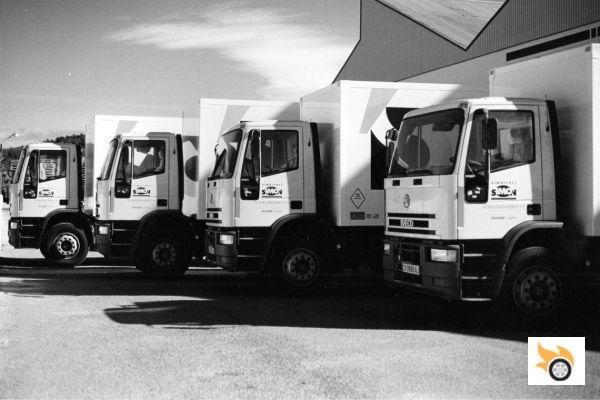This vehicle is remembered for the so-called Operation Palmera, a special advertising campaign that consisted of all the trucks leaving the Madrid factory for the different Spanish dealerships in chassis cab configuration and sporting an imposing advertising panel on the back with its price, less than half a million pesetas.
This vehicle is also part of the history of large Spanish public companies as it was widely used, especially by the Ministry of Public Works (MOP). Later it would be known that one of the reasons why the State used this vehicle almost exclusively was due to the strange need of Francisco Franco to stop the commercial adventures of the businessman Eduardo Barreiros. Other literature reports that since it was a state-owned company, it was logical for the state to opt mainly for its products and I believe that in the end it was due to a strategic combination of both arguments.
Characteristics that identify this truck are that it was the first Pegaso to have a single-piece front window, to launch a tractor unit with three axles and to manufacture the 3040 model with four-wheel drive.
As you can imagine, this series also had its own buses, although with a slightly more bizarre commercial life due to the fact that shortly after its launch the brand began to commercially group its bus division under the name of Series 5000, of which the manufacturer only made the chassis on which the bodywork manufactured by the Seida companies was mounted, Carde or Escoriaza (today CAF), bodies that over time showed a characteristic image of each coachbuilder and that in their continuous evolutions were moving away from the aesthetics of the Pegaso trucks.
Pegaso 6000
When you want to tell the history of Pegaso and you want to talk about buses, the most prudent thing to do is to talk more about chassis than about buses properly understood as such, but if in this article I talk about the 6000 series it is because of the great importance they had in the development of urban transport in our country, especially those versions equipped with Italian Monotral bodywork, which with their successes, their failures and, why not say it, their coincidences, have been in force until the end of the 80s when ENASA was bought by IVECO.
Known to all enthusiasts, the first series that is really part of the landscape of any Spanish city was the 6035. It was presented in 1964 as a substitute or evolution of the 6020 and 6021 models and was bodied by the company Jorsa, based in Mataró (Barcelona) and working under license from the Italian Viberti. This bus had a six-cylinder engine block, 10,170 cubic centimetres, 170 horsepower and Wilson semi-automatic four-speed gearbox. Once it had passed the test period in Barcelona, it began to be marketed in January 1965 and it can be said that it was the cause of the end of the trams.
Shortly after its presentation came another historic milestone in Spanish industry: the first nationally manufactured articulated bus. The first units reached a length of 18 metres and could carry 180 passengers, but had to be shortened to 16.5 metres to comply with current regulations.
These articulated buses, in spite of being practically the same as the 6035, received the name of series 2000 or 3000 and were bodied by Hugas those destined to the city council of Barcelona and by Nogue those destined to the city council of the capital. Despite this, the differences were basically of nuance and remained in force until 1981. This bus remained in force until the arrival of the 80's with many variations in its bodywork often made by the end customer, but with the mechanical parts rather old-fashioned to which only the necessary modifications had been made to moderate consumption and limit emissions.
Its replacement began to be developed in the mid-1970s under the name Pegaso 6050, recognisable by its very square bodywork, but quickly reminiscent of its predecessor. This prototype had two advances that were well received as the flat interior floor and the new 210 horsepower engine. However, shortly after entering into circulation there appeared numerous problems related to the insufficient surface of the radiator and the systematic breakage of the fan belts, which made the manufacturer put into circulation a model with the bodywork of the 6050 but with the very old mechanics of the 6035: it received the name of 6038 and I believe that it is also known by all the Spaniards.
The Pegaso 6038 was replaced by the Pegaso 6420 in 1985. This bus was actually a MAN SL/200 that had been produced as early as 1973 but was technically superior to the Pegaso 6038 in every way. This is due to the fact that already in the 80's talks had begun to sell ENASA to a foreign company and at that time MAN was the most likely...
Sava J4
Sava? Yes, it was. The Sava J4 van was actually a Morris Commercial J4 manufactured in Spain under license from Morris Motor Company by the company Sociedad Anónima de Vehículos Automóviles (SAVA). This manufacturer from Valladolid also manufactured other larger industrial vehicles under license from well-known foreign companies such as Austin, Berliet or BMC. It was also the first Spanish manufacturer to market a van with a diesel engine, the Sava P58 with a Barreiros engine.
This manufacturer was absorbed by ENASA at the end of the 60's, which decided to maintain the production of the Sava J4 for strategic needs but cancelled the production of the rest of the models to avoid competition with the Pegaso models. The first units of this van launched to the market in 1965 had a diesel block of 1,489 cubic centimetres and 40 horsepower as the only available engine, since it had been discarded to market in Spain a version with a petrol engine that the Morris model did have.
This van was evolving gradually but always kept its basic structure unchanged and we must look for changes in small improvements in the interiors, in the shapes of the optics both front or rear or in the change of anagrams once it began to be sold under the Pegaso brand. What was improved over time was the mechanical offer and at the end of its commercial life offered engines up to 1794 cubic centimeters and 50 horsepower.
This more powerful engine had a curiosity and that is that having been initially designed to be powered by gasoline, in its conversion to diesel type placed the feed pump in the hole that was arranged for a supposed delco.

The "square cab
At the end of the sixties Spain was really isolated from the rest of Europe in social, economic and industrial aspects. This isolation was not due to the Pyrenees but to the "protectionist" measures of Francisco Franco's government. These measures bothered (secretly, of course) an incipient industrial fabric of quality that was developing in our country and that had been replacing little by little the almost artisan commercial processes that were developed throughout the Spanish geography.
This new industrial fabric needed modern and reliable transport in order to grow and ENASA's answer was the Pegaso 1080, a truck that had been in the pipeline since the mid-sixties and designed by the Italian Aldo Sessano, also known for the design of the Seat 1200 Sport or the Jeep Comander.
Unlike all the previous products, this Pegaso 1080 was a completely new model with almost no legacies of previous models, or so it was advertised when it was presented at the Barcelona Motor Show in 1972 to a very good reception.
The Pegaso 1080 had a large cabin, fully customizable in terms of colours and upholstery, a panoramic one-piece windscreen, three windscreen wipers and double front optics. It could be said that the first Spanish truck for long routes was born. It also had a very practical detail: the radiator grille had hinges for side opening. However, access to the engine was still a pending issue.
On a user level, a great advance was the introduction of an eight-speed manual gearbox that eliminated the dangerous manoeuvre of changing from low to high gears, which had to be done using both hands and, therefore, letting go of the steering wheel.
Although the Pegaso 1080 is spoken of as a generic name, this referred only to the 4×2 variant with a maximum authorised weight of 20 tonnes. Each configuration had its own numerical code and, for example, the three-axle configuration had the name Pegaso 1083 and the four-axle ones, also called "four legs", received the commercial name of 1086. The latter was the real king of national transport until the mid-eighties thanks to its maximum weight of up to 36 tonnes. For their part, the tractor units received another numbering differentiated by the first digit, which went from 1 to 2. Thus, the two-axle tractor unit was called Pegaso 2080 instead of 1080.
The decision on the mechanics of these trucks slowed down the commercial launch. At first the possibility of using the 11.5-litre capacity engines manufactured by Leyland, ENASA's main shareholder, was considered, but in the end it was decided to use a block manufactured in-house with a capacity of twelve litres. Incidentally, the Leyland blocks were eventually used by DAF in the 2800 and 3300 series, making these Dutch trucks a milestone in terms of reliability. This "twelve-litre" with six cylinders and four valves per cylinder had a feature that made it special to say the least: the basic variants offering 230 or 250 hp differed in that the most powerful one had a cylinder bore 5 millimetres larger, making it, in reality, a "thirteen-litre".

When the whole Pegaso 1080 family was presented, it was offered with atmospheric and supercharged engines of up to 352 horsepower, which was a European record to beat the 350 horsepower of the Scania 191. As a curious anecdote I can say that despite what I have said about the DAF trucks, the first big sale Pegaso made was precisely to Holland, to the company that started the work on the great dam.
Due to various unspecified problems that occurred on the assembly lines and which had their unacknowledged origin in a possible lack of engines to supply the market, ENASA launched the 1080 range on the market with basic engines already known from previous generations of Pegaso trucks based on the 10.5 litre block that offered 200 horsepower in its naturally aspirated version and 280 in its supercharged version.
Having said that, it's time to mention some of the 1080 family's shortcomings: the first one was access to the engine. While all European trucks were already equipped with a folding cab, Pegaso waited until 1975 to equip it in its trucks. Even Barreiros, which by then had already become Barreiros-Dodge, had been fitting the folding cab on its "twelve-litre" trucks for years. Moreover, this solution was not the most successful either because Pegaso continued to equip its trucks with the front radiator installed in a hatch at the front.
Another important shortcoming was that the lack of a heat exchanger for its most powerful engines meant that its reliability was perhaps not what its customers expected. In fact, the block that can be considered the most reliable was the one that offered 306 hp. At the end of the 70's a "square cab" with less width was introduced to replace the old Pegaso Comet. In addition to the clear visual effect, a distinctive element was that it had a single main headlight to replace the double front light of the "normal" models. This new version had a 6.5 litre block with 140 or 170 horsepower.
With the 80's came a profound update of the "square cab" which began to be commercially known as Pegaso Tecno. Although the changes may not seem much in the eyes of the uninitiated, we can almost speak of a complete remodelling of the bodywork and improvement in the performance of its engines. Even the most powerful model, which arrived soon after, was equipped with a 16-speed gearbox manufactured by ZF.
The main new features of the Pegaso Tecno compared to its predecessor were new, more comfortable and efficient parabolic springs, 60 centimetre wide bunks and a new driver's seat with optional air suspension. The "square cab" remained in use for almost 20 years until it was replaced by the Pegaso Troner, launched in 1987.

Pegaso Troner
The 1980s and the incorporation of Spain into the common market brought the need or almost the obligation to renew an old industrial fabric in order to be able to compete with similar opportunities in a new market of millions of Europeans. This need for renewal was also reflected in the need to offer products adapted to the expectations of a European market that was much more demanding than the Spanish one, but there was a problem: the general lack of liquidity in Spanish companies.
ENASA was no stranger to this almost global economic panorama and also offered a range of products of recognized reliability but totally outdated in relation to the new European competition. As a light vehicle it had the J4 van as the umpteenth evolution of the 1960 Morris Commercial J4, as a bus it offered the Pegaso 6420, a derivative of the 1972 MAN SL200 and as a truck with the "Square Cab" also from 1972. The solution came from the hand of another European partner: DAF. Together with this Dutch manufacturer, the company CabTec was created to create a new truck that would be sold as the Pegaso Troner and as DAF 95, which was presented by King Juan Carlos I of Spain at the 1987 Barcelona Motor Show.
This new Pegaso sought to inherit the fame and reliability of the 1080 series and to this end it can be said that it almost doubled the most popular versions, the 4×2 tractor and the four-axle rigid. In any case, when it arrived on the market in 1988 it did so with a single 360 hp engine and completely left aside the narrow cab versions.

Goodbye Pegaso, hello IVECO
At the end of the 80s and due to both the economic situation of ENASA itself and the democratic need to eliminate industrial structures that had their origins in the Franco regime, the progressive dismantling of the former INI forced the sale of ENASA in a long and controversial process that began in 1989.
The first offers for ENASA came from Japan, but they were rejected when the conditions included the need for the buyer to be a company with its tax domicile in a European Union country, which at that time was twelve. The second offer came from a consortium formed by MAN and Daimler-Benz, which proposed to acquire 80% of the shares and keep both the factories and the brand, but was also rejected because of the risk of monopoly and they were required to present the offer as individual companies.
In a third stage of the sale process, the European Commission rejected the other candidates Volvo, DAF and IVECO (yes, IVECO; I am not mistaken) to "smooth" the way for the German manufacturers, but they had already refused to present themselves individually and in the end INI accepted the least bad offer, made by IVECO, which offered 1.1.2 billion pesetas (about 7 million euros) for 60% of Pegaso, a much lower amount than the 28,000 million pesetas offered by the consortium formed by MAN and Daimler-Benz.
The result of this purchase was the improvement of the Pegaso Troner engine block, which increased its power to 400 hp and opened the hope that the new owners would resurrect such an important brand for Spain, but without any value for the Italians of IVECO, who little by little began to limit the Pegaso offer and replace it with IVECO trucks.
This decision was not very well taken from the high Spanish political spheres because it meant the end of Pegaso. Furthermore, as if that were not enough, the delegate of IVECO, Giancarlo Boschetti, went so far as to affirm to a well-known newspaper that Pegaso was a "sick" brand, that for its purchase they had to negotiate in a great hurry to beat Mercedes' offer (the same one that quadrupled IVECO's) and that in the end, with the purchase of 100% of ENASA, they had invested much more than expected.
Logically, these statements were quickly "qualified" by the Italian consortium, correcting Mr. Boschetti's words and referring to the great importance of the Spanish market for the European expansion of IVECO, a "young" brand that was born in 1975 from the merger of five other brands (Fiat Veicoli Industriali, OM, Lancia Veicoli Spaciali, Unic and Magirus).
Today IVECO has two factories in Spain (Madrid and Valladolid) and directly employs more than 3,700 people, something very commendable in these times, and plans to increase its market share to 30% of the market, but its plans do not include relaunching the Pegaso brand.
To mark the 70th anniversary of Pegaso, IVECO will launch the Stralis Pegaso as a limited series of 140 units based on the Stralis XP. Once these units have been sold we will be able to say that Pegaso has died for the second time.
Epilogue: the Pegasus story on video
IVECO took the trouble to make a video summary of the history of the Spanish brand, in two clips that last almost a quarter of an hour in total, and another that summarises the story in just over three minutes:

























